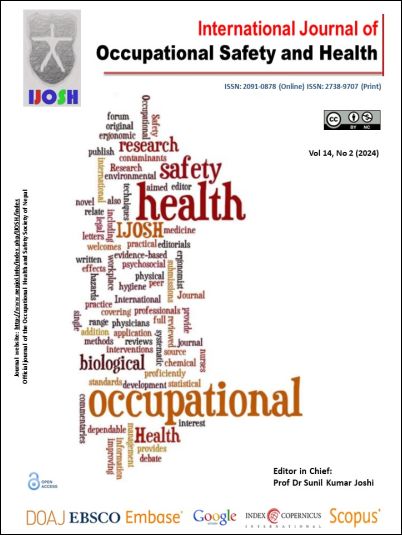Safety measures in the workplace: a case study of Federal Road Safety Corps (FRSC) vehicle plate manufacturing plant, Ojodu – Lagos, Nigeria
DOI:
https://doi.org/10.3126/ijosh.v14i2.52192Keywords:
Biochemical parameters, Hazards, PPE, Safety and Health, Toxic ChemicalsAbstract
Introduction: Hazards associated with vehicle number plate manufacturing processes in developing countries have not been well elucidated. There is a need to investigate hazards in the vehicle number plate manufacturing plant. The study aimed to identify self-reported hazards in the vehicle plate manufacturing factory, explore their effect on workers’ health and recommend mitigation strategies.
Methods: A descriptive cross-sectional study of workers in the vehicle plate manufacturing plant was done to identify hazards, protective measures and self-reported effects on workers’ health. Biochemical analysis of blood samples was also done and outliers were noted. ANOVA test was performed to determine differences in mean values of selected biochemical parameters. A p-value of less than 0.05 was considered statistically significant.
Results: Exposure to toxic chemicals 38(69%), excessive noise 36 (65%) and heat 28 (51%) were the major hazards in the factory. Major health problems were stress and fatigue 41 (71%), skin disorders 28 (51%), respiratory problems 18 (33%) and hearing loss 16 (29%). More than one quarter, 17 (30 %) of the workers admitted not using personal protective equipment (PPE) regularly. Periodic medical tests were not done for 13 (24%) of the workers. Potassium (3%), Urea (10%), Creatinine (7%), Aspartate transaminase (18%) and Alanine transaminase (8%) were elevated among the workers but no significant association could be established between elevated levels and work post.
Conclusion: Workers in the plate number manufacturing plant were mostly exposed to toxic chemicals and noise. Elevated electrolyte levels cut across departments. There is a need for better enforcement of safety rules, and periodic medical examinations should be conducted more consistently.
Downloads
Downloads
Published
How to Cite
Issue
Section
License
Copyright (c) 2024 The Author(s)

This work is licensed under a Creative Commons Attribution-NonCommercial 4.0 International License.
This license enables reusers to distribute, remix, adapt, and build upon the material in any medium or format for noncommercial purposes only, and only so long as attribution is given to the creator.





